Performance Analysis of a Double Pass Solar Air Thermal Collector with Porous Media Using Lava Rock
Abstract
:1. Introduction
2. Research Methodology
2.1. Design Concept
- It has high porosity;
- It has a low density;
- It has high moisture absorption;
- It has a high heat capacity (capability to retain heat).
2.2. Mathematical Model Using the Energy Balance Method
- The analysis is 1-dimensional;
- The heat capacity of glass, absorber plate, and back surface is negligible;
- Only the heat capacity of the porous material is considered in the transient analysis;
- The thermal resistance of the glass cover and the backplate are assumed to be negligible.
2.3. Validation of the Mathematical Model
3. Results and Discussion
3.1. Determination of the Optimum Mass Flow Rate
3.2. Determination of the Optimum Porosity
3.3. The Variation with the Time of the Day
3.4. The Use of DPSAH with Lava Rock in Agricultural Drying
4. Conclusions
- With the use of lava rock, the optimum thermal efficiency for the DPSAH that can be achieved ranges from 62% to 64% at a mass flow rate of 0.035 kg/s and at irradiances between 500 W/m2 and 800 W/m2;
- A porosity of 89% is the most suitable for considering the pressure drop and thermal efficiency trade-off;
- The optimal temperature output range between 41.7 °C and 48.3 °C can be utilized to dry food, resulting in better food quality;
- Compared to conventional double-pass solar air heaters (DPSAH), the overall temperature output of the DPSAH with lava rock is higher by approximately 17.5%;
- The use of lava rock significantly impacts heat storage and can maintain continuous heat when employed for solar drying under the Malaysian climate.
Author Contributions
Funding
Institutional Review Board Statement
Informed Consent Statement
Data Availability Statement
Acknowledgments
Conflicts of Interest
Nomenclature
| Area of solar collector ( | |
| Area of porous ( | |
| Wetted area ( | |
| Specific heat capacity of fluid | |
| Specific heat capacity porous | |
| Collector depth | |
| The equivalent diameter of packed bed | |
| Characteristic length | |
| Equivalent diameter | |
| Friction factor | |
| Heat-transfer coefficient | |
| Irradiation | |
| Thermal conductivity | |
| Length | |
| Thickness | |
| Mass flow rate | |
| Mass of porous | |
| Nusselt number | |
| Prandtl number | |
| Pressure drops | |
| Reynold number | |
| Temperature | |
| Loss coefficient | |
| Velocity | |
| Volume | |
| Collector width | |
| Subscripts | |
| Ambient | |
| Backplate | |
| Fluid | |
| Glass | |
| Inlet | |
| Porous media | |
| Outlet | |
| Plate | |
| Porous media | |
| Radiation | |
| Sky | |
| Top | |
| Thermal | |
| Insulation | |
| Wind | |
| Refer to the first and second stream of fluid | |
| Greek | |
| Absorptivity | |
| Porosity | |
| Efficiency | |
| Density | |
| Transmissivity | |
| Thickness of porous | |
| Viscosity | |
| Stefan’s Boltzmann constant | |
References
- Cassidy, V.M. Solar Collectors. In Solar Heating and Cooling Systems; Academic Press: Cambridge, MA, USA, 2017; Volume 46, pp. 29–97. [Google Scholar] [CrossRef]
- Hamid, A.S.A.; Ibrahim, A.; Mat, S.; Sopian, K. Experimental evaluation on large scale solar dryer for drying natural fiber in Malaysia. Int. J. Renew. Energy Res. 2019, 9, 598–604. [Google Scholar]
- Hamid, A.S.A.; Ibrahim, A.; Assadeg, J.; Ahmad, E.Z.; Sopian, K. Techno-economic Analysis of a Hybrid Solar Dryer with a Vacuum Tube Collector for Hibiscus Cannabinus L Fiber. Int. J. Renew. Energy Res. 2020, 10, 1609–1613. [Google Scholar]
- Ramani, B.M.; Gupta, A.; Kumar, R. Performance of a double pass solar air collector. Sol. Energy 2010, 84, 1929–1937. [Google Scholar] [CrossRef]
- Li, C.; Li, C.; Lyu, Y.; Qiu, Z. Performance of double-circulation water-flow window system as solar collector and indoor heating terminal. Build. Simul. 2020, 13, 575–584. [Google Scholar] [CrossRef]
- Belessiotis, V.; Delyannis, E. Solar drying. Sol. Energy 2011, 85, 1665–1691. [Google Scholar] [CrossRef]
- Lamrani, B.; Draoui, A.; Kuznik, F. Thermal performance and environmental assessment of a hybrid solar-electrical wood dryer integrated with Photovoltaic/Thermal air collector and heat recovery system. Sol. Energy 2021, 221, 60–74. [Google Scholar] [CrossRef]
- Luan, N.T.; Phu, N.M. First and second law evaluation of multipass flat-plate solar air collector and optimization using preference selection index method. Math. Probl. Eng. 2021, 2021, 5563882. [Google Scholar] [CrossRef]
- Mahmood, A.J.; Aldabbagh, L.B.Y.; Egelioglu, F. Investigation of single and double pass solar air heater with transverse fins and a package wire mesh layer. Energy Convers. Manag. 2015, 89, 599–607. [Google Scholar] [CrossRef]
- Alam, T.; Kim, M.H. Performance improvement of double-pass solar air heater—A state of art of review. Renew. Sustain. Energy Rev. 2017, 79, 779–793. [Google Scholar] [CrossRef]
- Sopian, K.; Alghoul, M.A.; Alfegi, E.M.; Sulaiman, M.Y.; Musa, E.A. Evaluation of thermal efficiency of double-pass solar collector with porous-nonporous media. Renew. Energy 2009, 34, 640–645. [Google Scholar] [CrossRef]
- Sopian, K.; Supranto; Daud, W.R.W.; Othman, M.Y.; Yatim, B. Thermal performance of the double-pass solar collector with and without porous media. Renew. Energy 1999, 18, 557–564. [Google Scholar] [CrossRef]
- Aldabbagh, L.B.Y.; Egelioglu, F.; Ilkan, M. Single and double pass solar air heaters with wire mesh as packing bed. Energy 2010, 35, 3783–3787. [Google Scholar] [CrossRef]
- Roy, A.; Hoque, E.; Islam, S.; Sarker, R.I.; Das, B.K. Efficiency Enhancement of Two Pass Solar Collectors with Steel Matrix in the Region of Rajshahi, Bangladesh. Int. J. Mech. Eng. Autom. 2017, 4, 71–76. [Google Scholar]
- Ahmed, O.K.; Mohammed, Z.A. Influence of porous media on the performance of hybrid PV/Thermal collector. Renew. Energy 2017, 112, 378–387. [Google Scholar] [CrossRef]
- Monem, M.A.; Akram, M.W.; Hossain, M.M.; Islam, M.R. Design and Performance Analysis of a Double Pass Solar Air Heater Using Black Coated Wire Mesh in Bangladesh Perspective. In Proceedings of the International Conference on Mechanical Engineering and Renewable Energy 2019 (ICMERE2019), Chittagong, Bangladesh, 11–13 December 2019; Volume 1, pp. 11–13. [Google Scholar]
- Singh, S.; Dhruw, L.; Chander, S. Experimental investigation of a double pass converging fi nned wire mesh packed bed solar air heater. J. Energy Storage 2019, 21, 713–723. [Google Scholar] [CrossRef]
- Velmurugan, P.; Kalaivanan, R. Energy and exergy analysis of solar air heaters with varied geometries. Arab. J. Sci. Eng. 2015, 40, 1173–1186. [Google Scholar] [CrossRef]
- Dissa, A.O.; Ouoba, S.; Bathiebo, D.; Koulidiati, J. A study of a solar air collector with a mixed “porous” and “non-porous” composite absorber. Sol. Energy 2016, 129, 156–174. [Google Scholar] [CrossRef]
- Singh, S.; Dhiman, P. Exergoeconomic analysis of recyclic packed bed solar air heater- sustained air heating system for buildings. J. Energy Storage 2016, 5, 33–47. [Google Scholar] [CrossRef]
- Singh, S.; Dhiman, P. Analytical and experimental investigations of packed bed solar air heaters under the collective effect of recycle ratio and fractional mass flow rate. J. Energy Storage 2018, 16, 167–186. [Google Scholar] [CrossRef]
- Hernández, A.L.; Quiñonez, J.E.; López, F.H. Transient numerical study of thermo-energetic performance of solar air heating collectors with metallic porous matrix. Sol. Energy 2019, 178, 181–192. [Google Scholar] [CrossRef]
- Güler, H.Ö.; Sözen, A.; Tuncer, A.D.; Afshari, F.; Khanlari, A.; Şirin, C.; Gungor, A. Experimental and CFD survey of indirect solar dryer modified with low-cost iron mesh. Sol. Energy 2020, 197, 371–384. [Google Scholar] [CrossRef]
- Singh, S. Experimental and numerical investigations of a single and double pass porous serpentine wavy wiremesh packed bed solar air heater. Renew. Energy 2020, 145, 1361–1387. [Google Scholar] [CrossRef]
- Regar, L.; Amjad, A.I. Ancient Mineral Fibre for Green and Sustainable Development. Tekstilec 2016, 59, 321–334. [Google Scholar] [CrossRef]
- Straaten, P.V. Rocks for Crops: Agrominerals of Sub-Saharan Africa; International Centre for Research in Agroforestry ICRAF: Nairobi, Kenya, 2002; p. 338. ISBN 0889555125. [Google Scholar]
- Marty, J.; Ernst, G.G.J. Volcanoes and the Environment; Cambridge University Press: Cambridge, UK, 2005; ISBN 9780521592543. [Google Scholar]
- Robertson, J.C.; Kerr, R.C. Solidification dynamics in channeled viscoplastic lava flows. J. Geophys. Res. Solid Earth 2012, 117. [Google Scholar] [CrossRef]
- Watmuff, J.H.; Charters, W.W.S.; Proctor, D. Solar and wind induced external coefficients-solar collectors. Coop. Mediterr. Energie Sol. 1977, 56. Available online: https://www.researchgate.net/publication/234355019_Solar_and_wind_induced_external_coefficients_-_Solar_collectors (accessed on 1 November 2021).
- Swinbank, W.C. Long-wave radiation from clear skies. Q. J. R. Meteorol. Soc. 1963, 89, 339–348. [Google Scholar] [CrossRef]
- Heaton, H.S.; Reynolds, W.C.; Kays, W.M. Heat transfer in annular passages. Simultaneous development of velocity and temperature fields in laminar flow. Int. J. Heat Mass Transf. 1964, 7, 763–781. [Google Scholar] [CrossRef]
- Gnielinski, V. New equations for heat and mass transfer in turbulent pipe and channel flow. Int. Chem. Eng. 1976, 16, 359–368. [Google Scholar]
- Wang, C.; Gao, P.; Tan, S.; Wang, Z. Forced convection heat transfer and flow characteristics in laminar to turbulent transition region in rectangular channel. Exp. Therm. Fluid Sci. 2013, 44, 490–497. [Google Scholar] [CrossRef]
- Dixon, A.G.; Cresswell, D.L. Theoretical prediction of effective heat transfer parameters in packed beds. AIChE J. 1979, 25, 663–676. [Google Scholar] [CrossRef]
- Duffie, J.; Beckman, W.; Worek, W. Solar Engineering of Thermal Processes; John Wiley & Sons, Inc.: Hoboken, NJ, USA, 1994. [Google Scholar]
- Beckman, W.A. Solar Engineering of Thermal Processes; John Wiley & Sons, Inc.: Hoboken, NJ, USA, 2013; ISBN 9780470873663. [Google Scholar]
- Garg, H. Advances in Solar Energy Technology: Volume 3 Heating, Agricultural and Photovoltaic Applications of Solar Energy; Springer: New York, NY, USA, 2012. [Google Scholar]
- Forson, F.K.; Nazha, M.A.A.; Rajakaruna, H. Experimental and simulation studies on a single pass, double duct solar air heater. Energy Convers. Manag. 2003, 44, 1209–1227. [Google Scholar] [CrossRef]
- Ong, K.S. Thermal performance of solar air heaters: Mathematical model and solution procedure. Sol. Energy 1995, 55, 93–109. [Google Scholar] [CrossRef]
- Fudholi, A.; Ruslan, M.H.; Othman, M.Y. Mathematical Model of Double-Pass Solar Air Collector. In Latest Trends in Renewable Energy and Environmental Informatics; WSEAS Press: Marathon, Greece, 2013; pp. 279–283. [Google Scholar]
- White, F.M. Fluid mechanics. McGraw-Hill Series in Mechanical Engineering; McGraw-Hill Education: New York, NY, USA, 2011. [Google Scholar]
- Daugherty, R.L. Fluid Mechanics with Engineering Applications; McGraw-Hill Education: New York, NY, USA, 1989; ISBN 1259002276. [Google Scholar]
- Ergun, S. Fluid flow through packed columns. Mater. Sci. 1952, 49, 89–94. [Google Scholar]
- Mustapha, M.; Fudholi, A.; Sopian, K. Mathematical modelling of bifacial photovoltaic-thermal (BPVT) collector with mirror reflector. Int. J. Renew. Energy Res. 2020, 10, 654–662. [Google Scholar]
- El-Sebaii, A.A.; Aboul-Enein, S.; Ramadan, M.R.I.; El-Bialy, E. Year round performance of double pass solar air heater with packed bed. Energy Convers. Manag. 2007, 48, 990–1003. [Google Scholar] [CrossRef]
- Dubey, S.; Tay, A.A.O. Testing of two different types of photovoltaic–thermal (PVT) modules with heat flow pattern under tropical climatic conditions. Energy Sustain. Dev. 2013, 17, 1–12. [Google Scholar] [CrossRef]
- Sarhaddi, F.; Farahat, S.; Ajam, H.; Behzadmehr, A. Exergetic performance assessment of a solar photovoltaic thermal (PV/T) air collector. Energy Build. 2010, 42, 2184–2199. [Google Scholar] [CrossRef]
- Jarimi, H.; Bakar, M.N.A.; Othman, M.; Din, M.H. Bi-fluid photovoltaic/thermal (PV/T) solar collector: Experimental validation of a 2-D theoretical model. Renew. Energy 2016, 85, 1052–1067. [Google Scholar] [CrossRef]
- Goyal, R.K.; Tiwari, G.N.; Garg, H.P. Effect of thermal storage on the performance of an air collector: A periodic analysis. Energy Convers. Manag. 1998, 39, 193–202. [Google Scholar] [CrossRef]
- Singh, S.; Dhiman, P. Using an analytical approach to investigate thermal performance of double-flow packed-bed solar air heaters with external recycle. J. Energy Eng. 2015, 141, 1–11. [Google Scholar] [CrossRef]
- Jalil, J.M.; Ali, S.J. Thermal Investigations of Double Pass Solar Air Heater with Two Types of Porous Media of Different Thermal Conductivity. Eng. Technol. J. 2021, 39, 79–88. [Google Scholar] [CrossRef]
- Reza, M.S.; Bapary, M.A.J.; Islam, M.N.; Kamal, M. Optimization of marine fish drying using solar tunnel dryer. J. Food Process. Preserv. 2009, 33, 47–59. [Google Scholar] [CrossRef]
- Yusuf Sukman, J. Dried longtime in making herbal tea fragrant pandan leaves (Pandanus amarylifolius Roxb.) activities of antioxidant. Вестник Росздравнадзора 2017, 4, 9–15. [Google Scholar]
- Blanco-Cano, L.; Soria-Verdugo, A.; Garcia-Gutierrez, L.M.; Ruiz-Rivas, U. Modeling the thin-layer drying process of Granny Smith apples: Application in an indirect solar dryer. Appl. Therm. Eng. 2016, 108, 1086–1094. [Google Scholar] [CrossRef]
- Oestergaard Jensen, S.; Correll Frank, F.; Floejgaard Kristensen, E. Survey on Solar Dryers for Drying of Food and Wood in Ghana; Danish Technological Institute: Taastrup, Denmark, 1999. [Google Scholar]
- Mujaffar, S.; Sankat, C.K. Modeling the Drying Behavior of Unsalted and Salted Catfish (Arius sp.) Slabs. J. Food Process. Preserv. 2015, 39, 1385–1398. [Google Scholar] [CrossRef]
- Fudholi, A.; Sopian, K.; Yazdi, M.H.; Ruslan, M.H.; Gabbasa, M.; Kazem, H.A. Performance analysis of solar drying system for red chili. Sol. Energy 2014, 99, 47–54. [Google Scholar] [CrossRef]


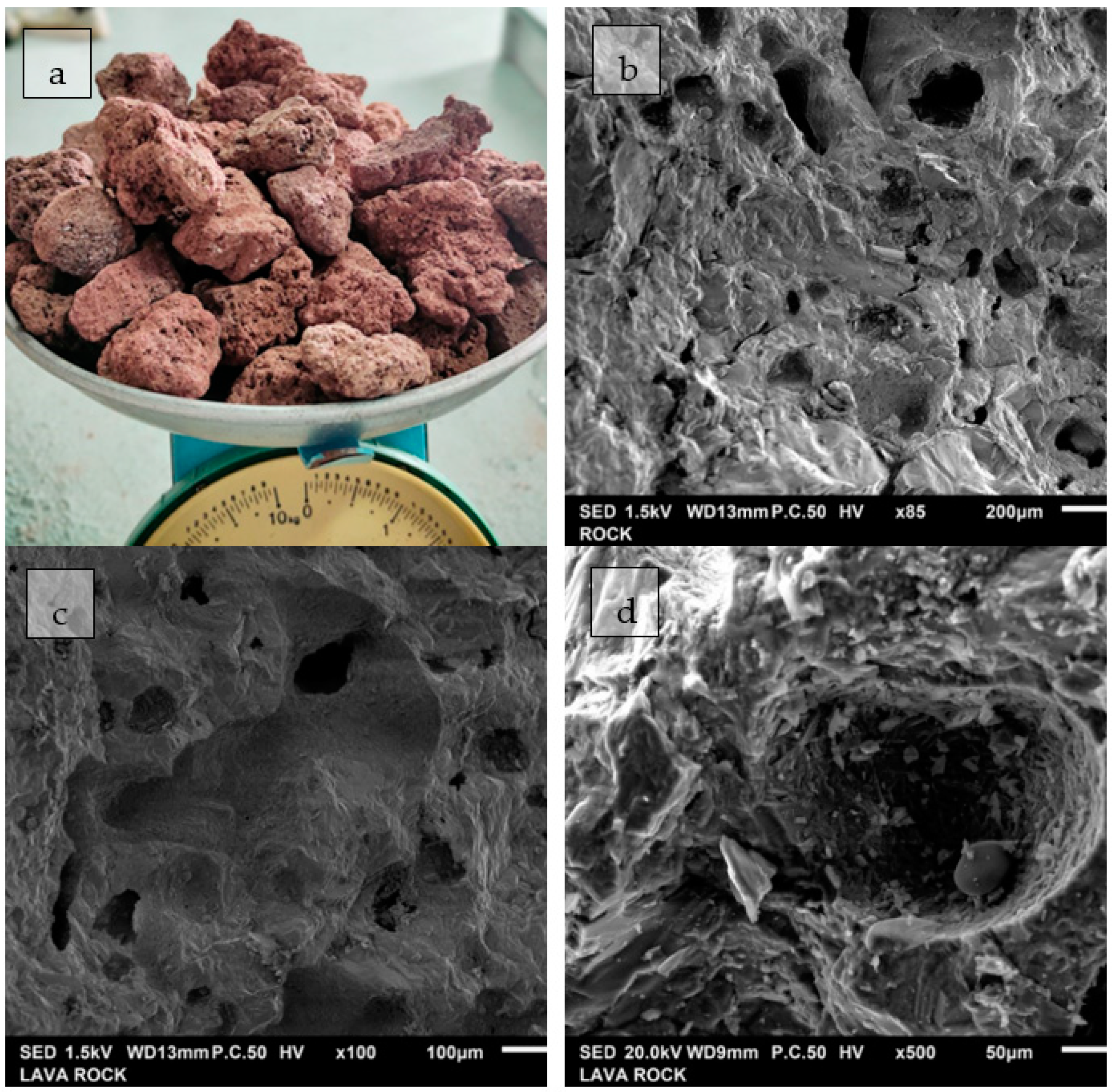
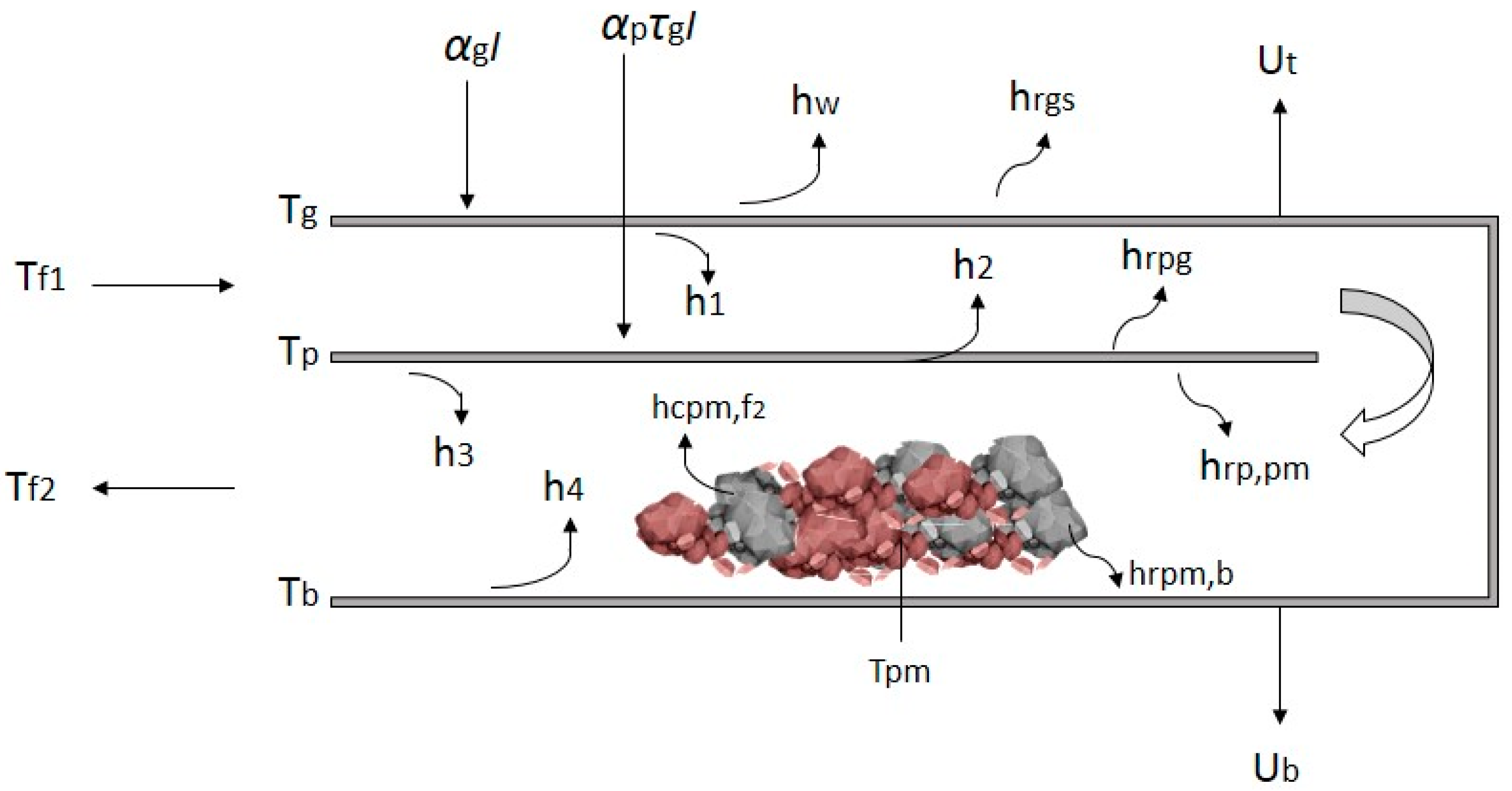
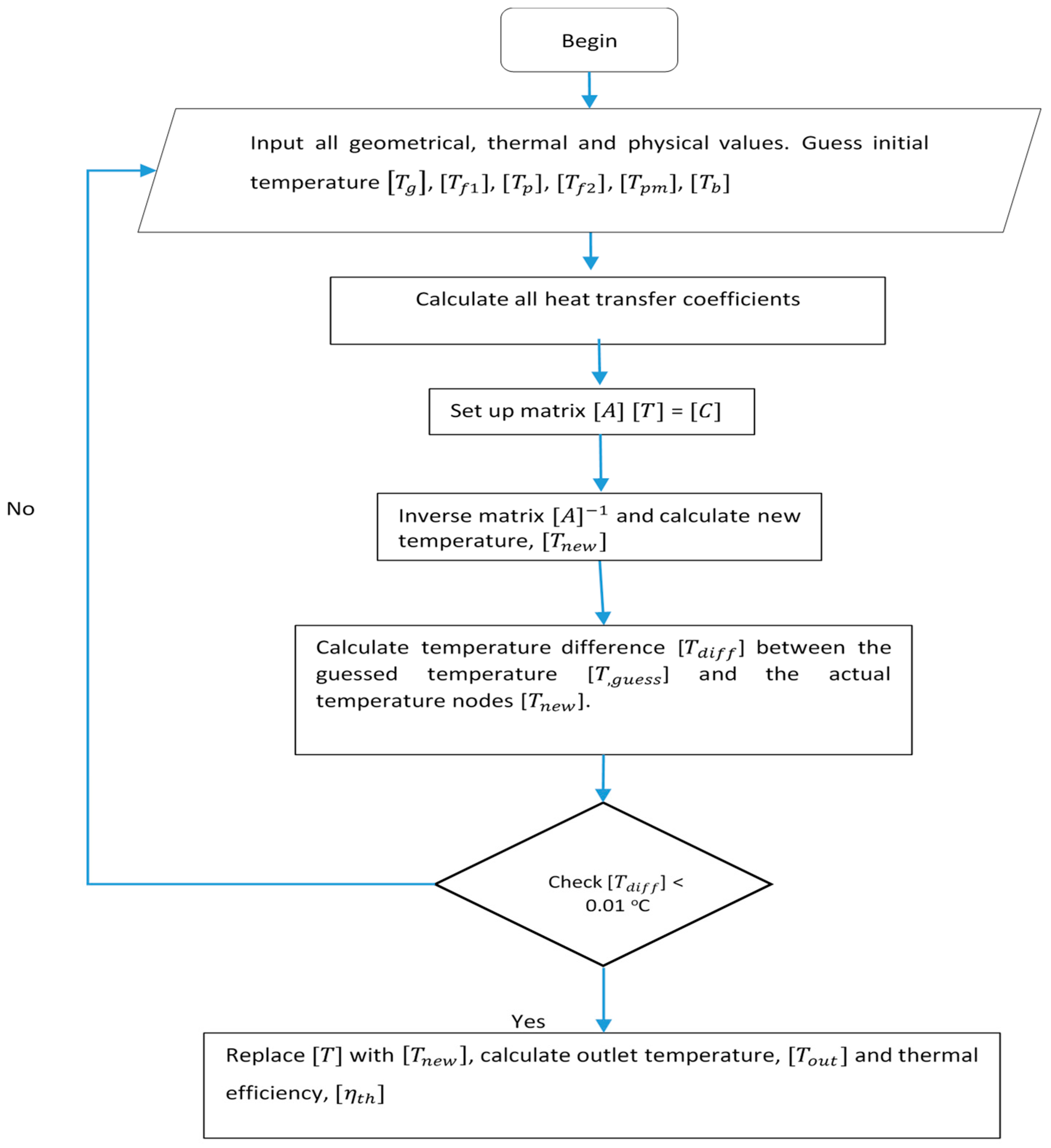


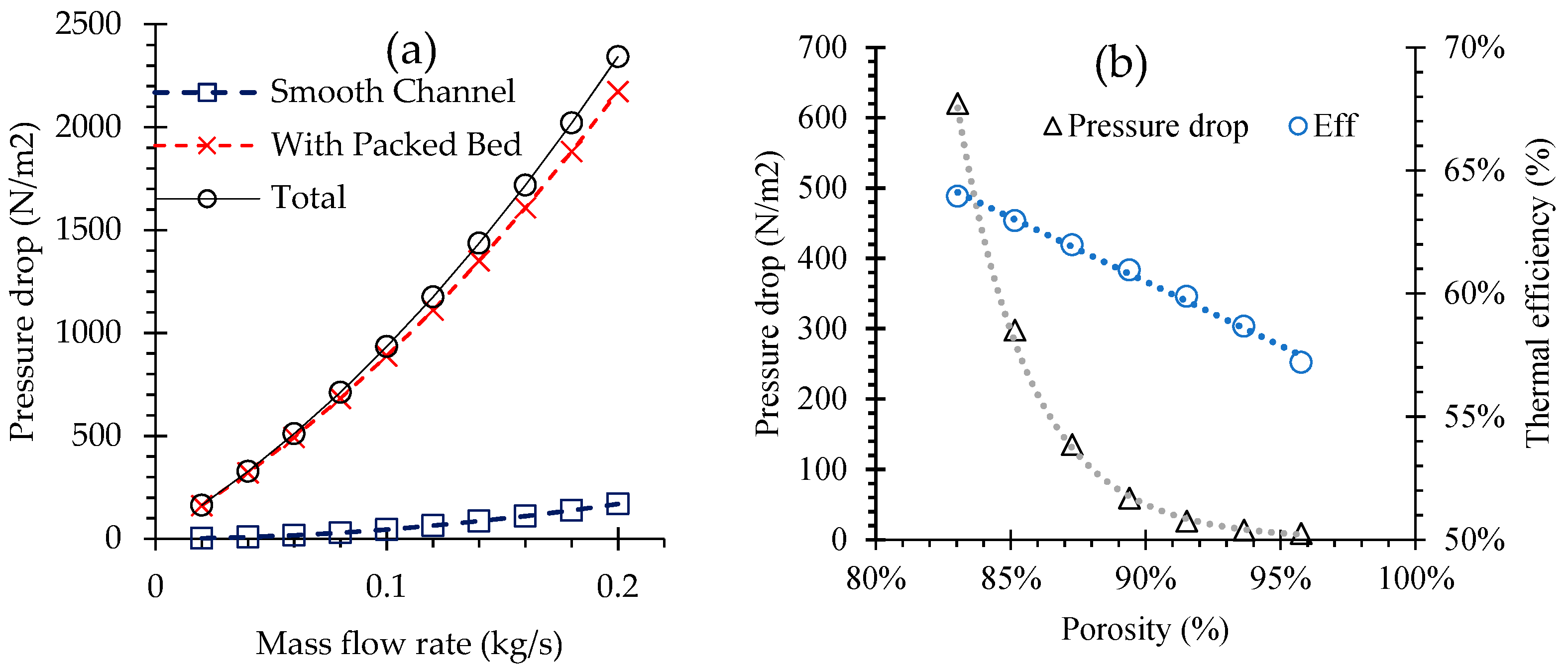
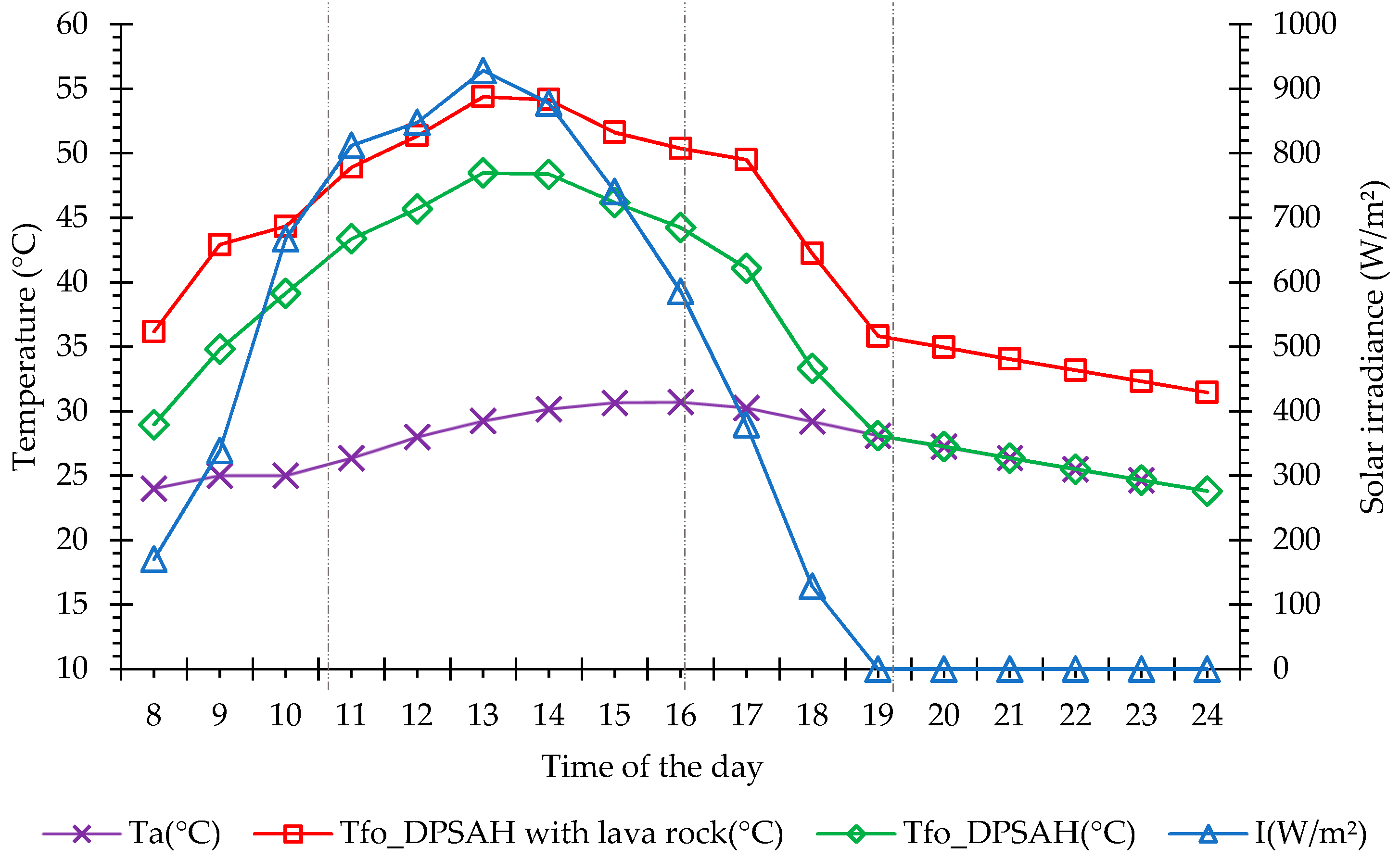
| Author | Year | Type of Porous Material |
|---|---|---|
| Mahmood et al. [9] | 2015 | Wire mesh |
| Roy et al. [14] | 2017 | Square shape steel wire mesh |
| Ahmed and Mohammed [15] | 2017 | Glass Sphere |
| Monem et al. [16] | 2019 | Black coated wire mesh |
| Singh et al. [17] | 2019 | Ten successive wire mesh |
| Author | Year | Type of Porous Material |
|---|---|---|
| Velmurugan and Kalaivanan [18] | 2015 | V-corrugated shaped wire mesh |
| Dissa et al. [19] | 2016 | corrugated iron sheet and mesh of aluminum |
| Singh and Dhiman [20] | 2016 | Wire mesh |
| Singh and Dhiman [21] | 2018 | Wire mesh |
| Hernández et al. [22] | 2019 | Porous matrix (in contact with absorber plate) |
| Güler et al. [23] | 2020 | Iron wire mesh |
| Singh [24] | 2020 | Serpentine wavy wire mesh |
| Parameters | Numerical Values |
|---|---|
| The volume of lower channel, | 0.09 |
| Ambient temperature, | 298.15 |
| Inlet air temperature, | 300.15 |
| Mass Flow rate, | 0.015, 0.02, 0.025, 0.03, 0.035, 0.04, 0.045, 0.05, 0.055, 0.06, 0.065 |
| Solar Irradiance, | 500, 600, 700, 800 |
| The transmittance of glass, | 0.80 |
| Absorption of glass, | 0.05 |
| Absorption of the plate, | 0.95 |
| An emissivity of glass, (Low emissivity coated glass) | 0.35 |
| An emissivity of the absorber plate, | 0.9 |
| An emissivity of the bottom plate, | 0.86 |
| An emissivity of porous material, | 0.93 |
| Sigma, | 5.670 × 10−8 |
| Thermal conductivity of insulation, | 0.038 |
| Thermal conductivity of porous, [28] | 1.56 |
| Specific heat capacity of porous, [28] | 1200 |
| The density of porous material, [28] | 2600 |
| Wind velocity, | 1 |
| Parameter | |
|---|---|
| RMSPD | 6.08% |
| MAPE | 5.46% |
| Ref. | Sample | Temperature | Remark |
|---|---|---|---|
| [52] | Marine fish | 45–50 °C | Products made at temperatures ranging from 45 °C to 50 °C were outstanding in taste, color, and texture. |
| [53] | Mint leaves | 40–50 °C | . |
| [54] | Apple slices | 20–50 °C | The thickness of the slice should be taken into account. |
| [55] | Cassava | 40–50 °C | Temperatures higher than 80 °C may reduce the quality of the crop. |
| [56] | Unsalted and Salted catfish | 50 °C | Drying for 8 h is recommended. |
| [57] | Red chili | 28–55 °C | Maximum moisture content can be reduced to 10% within 33 h, maintaining an average drying temperature of about 44 °C. |
Publisher’s Note: MDPI stays neutral with regard to jurisdictional claims in published maps and institutional affiliations. |
© 2022 by the authors. Licensee MDPI, Basel, Switzerland. This article is an open access article distributed under the terms and conditions of the Creative Commons Attribution (CC BY) license (https://creativecommons.org/licenses/by/4.0/).
Share and Cite
Ismail, A.F.; Abd Hamid, A.S.; Ibrahim, A.; Jarimi, H.; Sopian, K. Performance Analysis of a Double Pass Solar Air Thermal Collector with Porous Media Using Lava Rock. Energies 2022, 15, 905. https://doi.org/10.3390/en15030905
Ismail AF, Abd Hamid AS, Ibrahim A, Jarimi H, Sopian K. Performance Analysis of a Double Pass Solar Air Thermal Collector with Porous Media Using Lava Rock. Energies. 2022; 15(3):905. https://doi.org/10.3390/en15030905
Chicago/Turabian StyleIsmail, Amar Fahmi, Ag Sufiyan Abd Hamid, Adnan Ibrahim, Hasila Jarimi, and Kamaruzzaman Sopian. 2022. "Performance Analysis of a Double Pass Solar Air Thermal Collector with Porous Media Using Lava Rock" Energies 15, no. 3: 905. https://doi.org/10.3390/en15030905
APA StyleIsmail, A. F., Abd Hamid, A. S., Ibrahim, A., Jarimi, H., & Sopian, K. (2022). Performance Analysis of a Double Pass Solar Air Thermal Collector with Porous Media Using Lava Rock. Energies, 15(3), 905. https://doi.org/10.3390/en15030905








